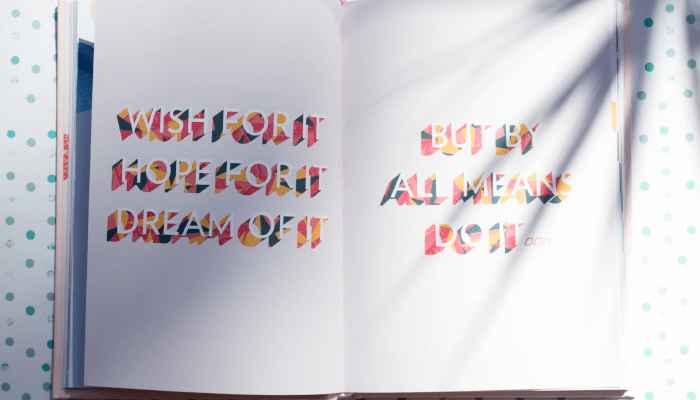10 Tips to Improve Your Typography Skills — DesignXplorer
Are you ready to improve your typography and take your game to the next level? Wonder how? Don’t worry, we got you covered! Today we are sharing 10 Tips to Improve Your Typography Skills -the craft of endowing human language with a durable visual form.
“When typography is on point, words become images.”
Shawn Lukas
If you have heard the term typography before but have no idea what it is all about in this article, we will cover that for you. In this article, we will provide you with all the necessary tools and insight you need to improve and perfect yourself at all small and obscure concepts of typography so you can create the best looking website designs. For the uninitiated when you hear typography, you probably think it has something to do with the very complicated specialization, but that’s actually isn’t the case. Actually, every designer uses typography in one way or another when they design creatives.
The term typography is the art of designing, selecting, and arranging type to make words readable.
The arrangement of the words involves a good understanding of selecting typefaces, line lengths, point sizes, leading (line spacing), and tracking (letter-spacing) and kerning (adjusting the space between pairs of letters). Type design is a closely related technique, sometimes considered part of typography. Oddly enough, most typographers do not design typefaces, and a lot of them do not even consider themselves typographers. Typography is also sometimes used as a decorative device, unrelated to communication of information.

So in nutshell typography stands for:
- Style or appearance of text.
- The art of working with text.
Now when you know what exactly this term stands for let’s see how to use typography more effectively in your design projects. You just need to follow our 10 tips to improve your typography skills:
There are plenty of tiny details that, when put together, make for great typography design. Some of them are obscure other overlooked, but they are all critical for creating the “bigger picture.”
1. Context and audience
When you start choosing fonts, an essential thing to keep in mind and ask yourself is, “What is the main goal here?”
There are plenty of font choices that will fit a specific need. Each individual font brings its own unique mood to the layout. Whether you choose a friendly, funny, serious, or business-themed font, this solely relies on your end goals and targeted audience. Every single font used has a specific character that conveys a different message to the reader.
Classic fonts are often used to convey a strong personality and are commonly used for the more mature audience, while the more modern fonts have cleaner and neutral look, usually the better choice for the younger audience. If you choose a font that looks too fun, it will look silly for a business website, and users will hesitate to trust the company. Same thing if a product is meant for youngsters, too formal fonts may seem dull.
Bold fonts are mainly used for making statements and have the power to immediately capture the attention of the reader, the same way yours was captured with ‘s quote at the beginning of this article.
2. Utilize white space properly
The “whitespace,” also known as “negative space” is the empty space between elements in a composition.
There are two sub-elements that make the “whitespace”:
Micro & Macro Whitespace
The space between significant elements in a composition is “Macro Whitespace.” It helps in giving the words “room to breathe.” “Micro Whitespace” is the space between smaller elements: between list items, between a caption and an image, or between words and letters — the itty-bitty stuff.
Using your white space evenly makes the content much more easy-looking and “scannable,” significantly improving your work. The thing about “whitespace” is as using silence in a musical composition. Without proportionate use of silence, the music turns into noise. Similarly, without “whitespace,” your design is unstructured and difficult to consume.
3. Appropriate Font Size
Choosing the proper font size is just as important as choosing the right type of font. You don’t want to be too big, but you don’t want it to be too small eighter.
How to choose a size when there are so many to choose from? Again, everything depends on the end goal. If you want your design to be expressing loud and clear bold statements or emphasize a specific word or sentence, you would most of the time want a bigger size but try using it sparingly.
If you are going for a more tender and subtle message, better go with a small or normal-sized font.
4. Use EMs or REMs
EMs and REMs are both essential units in typography, but how to know which one should you choose over the other?
EM units are based on the relative font size of the “parent” element. REM units, on the other hand, are based on the relative font size of the HTML element and act as a sort of a multiplier.
Most of the time, REM is going to be the go-to unit for you, but sometimes EM can be just as good and even better if you want the font to change based on the parent element.
Relative sizing is a big selling point to EMs because it helps control the sizing of elements as they relate to others. EMs function as essential building blocks to website elements thanks to the fact that EM values compound.
5. Set Up a Hierarchy
Beginners in typography often underestimate the necessity of using a hierarchy, and that makes their designs look poorly and unprofessional.
But setting up a hierarchy isn’t only used to impress your clients with your fantastic work structure, it makes everything a little bit more easy for you. Typographic hierarchy guides not only the audience but also to better focus on the more important points and makes it easier to differentiate them from the more simple and supporting parts.
Probably the most essential things in the hierarchy are position and alignment. You don’t have a well-structured hierarchy without mastering these two. The right positioning of the headings and the subheadings should be your top priority because they are the most impactful on the structuring your hierarchy.
After you have figured the positioning and alignment of your headings and subheading, try to make your type stand out. The way to do this is to center it or set it outside of the regular margins of a page. This can make that type stand out within the hierarchy of a page.
6. Learn to Kern
In its purest form, kerning is the art of adjusting the space between two individual letters. The goal here is to equalize the appearance of the white space between letters, so they appear better in front of the eyes of the readers. This can be tricky for the beginner because there is no mathematic form or algorithm to use, so you really have to develop an eye for it.
The only automatic tool in kerning you can use is tracking. Tracking is adjusting the spacing uniformly over a given selection of a text and is just a thing to help you do the same thing you have already done but faster.
Learning this skill is not the most difficult thing in the world, but mastering it will automatically make you ahead of your competition because you would be able to make your own unique type.

7. Pairing Fonts
Pairing fonts that compliment each other is an essential part of great results in typography designing. This is another thing that requires you to think outside of the box, but there is still a soft set of rules that you may want to follow.
Don’t be afraid to use unknown typefaces to you. Finding fonts that have style variants is a smart way to create nuance without unnecessarily overcomplicating your designs.
For example, a soft black Arima Madurai font combined with a light-colored background will make for a great pairing.
Experiment with a couple of your favorite fonts and also take inspiration from ads you saw before that made an impression on you and try to analyze what makes them work and use it.
8. Contrast is King
The opposites attract each other; this is also the case in typography. If you want to add a creative tinge to your text and want it to stand out, then contrast is one of the best and easiest tools in your design arsenal you can use.
Contrast is the second name for attention-grabbing. It effectively communicates the ideas you want to emphasize the most. Just as you need to know which font pairs well with others, you need to be aware and knowledgeable in using contrast to your advantage.
Another example of great use of contrast like the one above is bold and rounded white typeface combined with a contrasting in style darker red one on a black background.
This way, the contrast in both style and color captures the reader’s attention exactly where you want it to be. To choose the perfect color contrast, you can always go for the traditional monochrome, or if you have been using it for too long and want something different, go for a full-color design. To ensure the color contrast doesn’t affect negatively on the readability, match the color of your font with the background as it creates a cohesive look.
9. Ensure Better Readability
Of course, readability is important; after all, what is the point of making a complicated design. If all your audience sees is hard to read sentences? This may resolve in turning your audience off, leaving them with the feeling you take something away from them rather than giving them a good time looking at your work.
How to ensure better readability? Well… you just keep it simple honestly. Use simple words and phrases, also try to find short words. When readers “scan” through the words, they often tend to stay rather than leave, if there are short and simple words. That’s because this will take them less time to read, and we all know that nobody wants to waste their time.
10. Line Limit
Another way to ensure better readability is to have a line limit for your text. There are two “standards” of optimal line length for your body text. The first and the more popular one is 50–60 characters per line (including spaces). This is good for making short descriptions. The second one suggests that up to 75 characters is also acceptable and even preferable in a lot of instances where you need to give a little bit more info.
But why do you need to follow either of them, and what’s the downsides of violating these ranges?
An easy answer to this question is-your lines may appear either too wide or too narrow. If a line of a text is too long, the reader’s eyes will have a hard time. When the line length is difficult to gauge it becomes a problem and can affect negatively on the reader’s ability to focus onto the correct line in a large portion of a text. And if a line is too short, this also tends to stress the readers, making them start reading on the next line before finishing the current one, constantly making the eye travel back, breaking the reader’s rhythm, and potentially skipping important words.
Final Thoughts
Congratulations for making it this far through the article, now you are a few steps ahead on your journey in mastering typography.
We hope these 10 tips to improve your typography skills have been useful to you. Share your opinion about the topic in the comment section and stay tuned for more.
Source: Akbar Shah, https://medium.com/nyc-design/10-tips-to-improve-your-typography-skills-designxplorer-99cbe2704053, 10 Tips To Improve Your Typography Skill – DesignXplorer, Medium, Dec 13th, 2019

